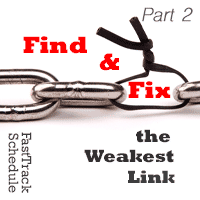 In Part 1 of this two-part series, we looked at what I considered to be things that we absolutely need on every project, no matter what the size, dollars or length in duration the project may be. I look forward to your thoughts and input on this topic based on your experiences. And be honest…tell us what you consider essential and what you tend to let go of for those projects of different sizes and importance. And who makes that call? Is it you?
In Part 1 of this two-part series, we looked at what I considered to be things that we absolutely need on every project, no matter what the size, dollars or length in duration the project may be. I look forward to your thoughts and input on this topic based on your experiences. And be honest…tell us what you consider essential and what you tend to let go of for those projects of different sizes and importance. And who makes that call? Is it you?
Let’s continue this discussion….
What isn’t needed?
There are many more documents that can be put together either officially or unofficially on a project. For a development or technical project, the functional design document (or FDD) and other similarly detailed technical documents. For projects, in general…the project charter, the project communication plan, the risk management plan, the disaster recovery plan, and the test plan to name a few. Certainly most of these need to exist in some form or another – even if they are an email covering the topic on a very small project. All of these MUST exist on large, detailed, and long-term projects. Most of these can be handled somewhat informally on very small, low-visibility and low-criticality projects. For example, you’re going to do some risk planning and issue tracking on every project – probably documented as part of the ongoing project status reporting that is performed. But on very small projects, there likely won’t be enough dollars in the planning phases of the project to cover the creation, review and approval of a formal risk management plan. That alone would likely cost $5k-$20k. Certainly not worth it for a project with a budget set at $30,000.
Summary
It’s all about scalability. From the project manager’s standpoint, we’d like every project to include standard documentation – it’s neat, tidy, ritualistic, and helps cover everyone’s hind end. But it’s not always practical. Just as the PM needs to recognize how to scale his own involvement to fit the project’s budget constraints, likewise he must do the same with the documentation activities on the project. I’d like to say that I’ve “gotten it right” on every engagement, but I haven’t. I’ve likely upset a few clients along the way with my omission of certain detail and documentation that I felt “unnecessary” for the project at hand. Why spend project dollars that we don’t need to spend (when they will likely be needed later on for unforeseen issues anyway)? But that can sometimes lead to a project client who thinks we are cutting corners on detail and may start to lose confidence in our attention to detail…so be careful. It is a fine line we sometimes walk as the project manager.
How about you? What do you toss out on the smaller projects that you otherwise include when the project is of greater size? Again, much of those “toss” materials need at least some thought and maybe warrant and email or two, but please share how you handle such situations.



